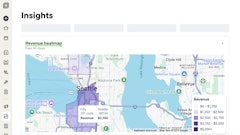
When autumn leaves fall, professional landscapers enter a slow period that can spark opportunities to build a more successful business. After all, who has time to shop for software, refresh systems and intensively train crews during peak season? Top green pros stay on their toes by leveraging the data they have no matter what season. Here are five suggestions to help you make the most of your GPS fleet tracking software so that when the busy season hits, you’ll be ready to rake in the bucks.
1. Take time to review maintenance plans and current vehicles and equipment in use.
Your tracking software should offer a module that allows you to update your equipment maintenance schedule with current usage data to track in real time and avoid downtime. During the offseason, that means performing any necessary upkeep to winterize and prepare for spring. Maintenance scheduling also allows you to look at the useful life of your major assets and plan for replacements. Is there spare equipment you could make better use of and “rotate in” or sell off? Now is the time to review the data and make decisions.
2. Review fuel costs per vehicle and driver.
Fuel efficiency is essential to cost savings. Check to see if your vehicles are meeting their expected miles per gallon performance standards. If there’s any efficiency loss, determine what’s causing it. Are drivers idling too long as they complete work, take breaks or plan routes? Are there any reckless driving incidents you need to address? Review your baselines and benchmarks to ensure that these are still relevant measures of success.
3. Optimize services and improve operational efficiencies.
Take time to compare your on-site service time against what you bid. Identify any discrepancies. This will help you tighten bids and prevent billing leakage. By comparing field service management data with GPS tracking data, you can also spot opportunities to improve vehicle usage and performance. Also, see if your teams are spending too much time on certain projects or working inefficiently. Are they rushing through the work or do they need more training? Now is the time to adjust. You may also benefit by analyzing and updating your customer database, but don’t waste time doing it manually; let your software do the heavy lifting.
4. Establish or optimize your safety program.
Don’t wait for an accident to make safety a priority. Use your software to identify areas for improvement, such as eliminating tight timelines, optimizing vehicle usage and tracking performance to spot trends where training can reduce risk and enhance outcomes. Institute or review your driver coaching program, ensuring that company policies, incentives and penalties are well documented and that performance expectations are understood. As well, many insurance companies offer discounts for onboard telematics or video assists. Check your insurance policy, understand the risks, review key metrics and adjust accordingly.
5. Make sure you’re getting the most out of your software systems.
Did you know most companies buy software and only use 10-20% of the available features? Don’t waste the investment. Learn how to use your software during slow months. Learn the features that can help you achieve your goals and improve your ROI—and make sure your system is right sized for your needs. Lots of advanced features or a complex user interface might be useful for an enterprise fleet, but without the right resources on staff, it could end up being too complicated and not useful. The right system will balance power with ease of use, presenting data in a way that’s easy to digest and practical to act on.
The bottom line is every season presents an opportunity to improve. Take advantage of your downtime to make the most of your uptime. Leverage your software investment on the strength of quality data.



















